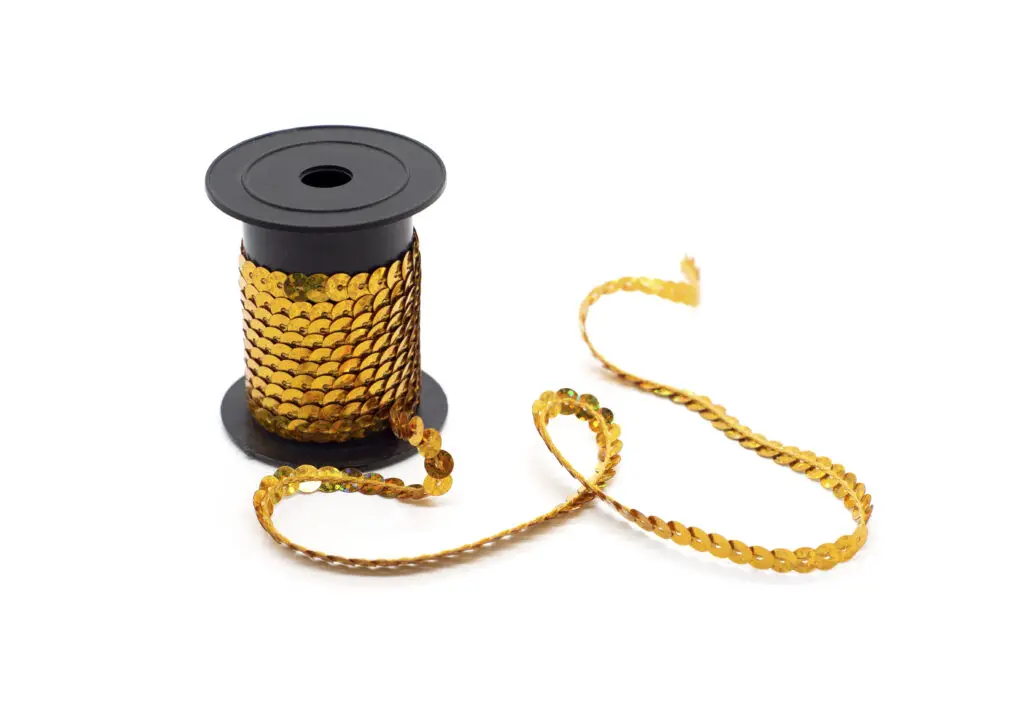
There’s nothing like a bit of sparkle to add glamour to a garment! Sewing with sequins is always fun, and it can add that little something extra to your home furnishings too. It can be tricky, however, so it’s important to know what you’re doing. With the right technique you can save time and get much better results.
Sequin Sewing Basics
For sewing with sequins you’ll need a fine but strong thread that won’t easily snap. Nylon is usually the best choice. Use a fine needle when sewing by hand; otherwise a ballpoint machine needle is best but you’ll need to sew slowly as it may break if jammed. Set the thread tension slightly low. Always pin or tack before you start using the machine.
Tailor’s chalk won’t always work on sequinned fabric, so use a light fabric tape for marking out your pattern – carefully applied, it won’t pull sequins free. Use strong, sharp scissors and be careful to keep them from sliding as you cut. In the process of cutting and preparing your fabric, some sequins will always be lost. Keep these – you can use them to cover up your finishings later.
Sewing with Sequinned Fabric
The simplest way to sew with sequins if to use fabric that is already covered in them. This comes in two basic types: lightweight, flat fabric; and elasticated fabric. The former is good for making shirts, saris and simple slip dresses. It also works well in costuming. The latter looks more dramatic and is good for waistbands, cuffs and tight-fitting evening wear.
Lightweight sequinned fabric is relatively easy to work with. You can cut straight through its sequins without difficulty and it should run smoothly through a properly set up machine. Elasticated sequinned fabric is more difficult as the usual issues with stretching and bunching are compounded by the sequins sitting at different angles, making it easy to get into tangles or jams.
When sewing with elasticated sequinned fabric, stretch it as far out as you can before you begin. If you have a sturdy bench or table for your sewing machine you may find it useful to attach a vice, as used in woodwork. This will hold one end of the fabric securely, keeping it taut as you work. You will, however, need to take it slowly and sew just a few inches at a time if you use this technique. Use a zigzag stitch for added strength.
Creating Sequinned Fabric
Sometimes you won’t be able to find sequinned fabric with the look you want. Your local sewing shop may have a very limited selection, you may want an unusual colour, or you may have a design in mind that combines a selection of different colours. It’s then time to create your own.
The easiest way to apply sequins to fabric is to iron them on, but remember you can only do this safely with fabrics that won’t be damaged by direct heat (you’ll need to set the iron to about 30°C). You’ll need to but special iron-on sequins but they’re not particularly expensive. Because they have their own heat-activated backing they’re easy to use. Simply place them where you want them, cover with a tea towel, and press with the iron for thirty seconds to fix them in place.
If you can’t find iron-on versions of the sequins you want, you can attach ordinary ones using fabric glue, but this is more time-consuming and can be messy. It’s best to practise first on fabric scraps. For best results, push each sequin onto a dot of glue so that the glue wells up slightly through the hole in the centre.
Alternatively, you can sew on sequins, either individually or by lining them up on your thread and attaching them in rows, then sewing across those rows to fix them in place.
Sewing Sequin Motifs
Even when it comes to glamour and glitz, sometimes less is more. Small sequin designs can add an exciting touch to otherwise plain garments. You can buy off-the-shelf sequinned appliqués to add to your creations but you may well have more fun designing your own.
Design is an important part of the process here. Don’t try to copy what you have in your head straight onto the garment. Instead, sit down and sketch it out with coloured pens or pencils. This will help you to assess how well it will work and how much space it will take up.
Sewing on sequins individually is very time consuming but can produce amazing results. Don’t forget that there’s a lot more out there than familiar round sequins. Check out the range of different shapes and styles available, and you’ll be thrilled by what you can create!
